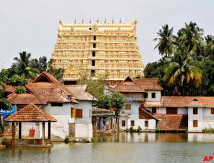 An intriguing controversy over a $22 billion archeological find in India is playing itself out now in that country. For those of us who are fascinated by jewelry and gemstones, their history, sources, and design drivers, I would suggest we have a stake in the outcome.
An intriguing controversy over a $22 billion archeological find in India is playing itself out now in that country. For those of us who are fascinated by jewelry and gemstones, their history, sources, and design drivers, I would suggest we have a stake in the outcome.
Recently, five of six “secret” vaults were opened beneath Padmanabhaswamy Temple in southern Kerala. The vaults had been sealed since the 16th century. According to news reports, the archeological find is one of the greatest ever made in India and consists of a “dazzling stash of gold ornaments, Napoleonic era coins and sacks of gemstones.”
If I understand this correctly, the 500 year-old temple is dedicated to Lord Vishnu and its wealth is considered the property of the temple. For centuries, it was guarded by the royal family of the area and they apparently have acted with great integrity over the centuries. According to news reports, the vaults were opened as a result of intensified calls to redistribute the wealth to improve living standards in the area.
 All jewelry manufacturers, including bead and pearl stringers, owe much to the jewelry and gemstones of India. Its lush jewelry inspired Pierre Cartier to create the “fruit salad” or “tutti fruitti” style of jewelry which opened the eyes of the west to Indian jewelry in the early part of the 20th century. Today, we bead and pearl stringers are often dazzled by the strands of colored stones imported by Indian gemstone suppliers.
All jewelry manufacturers, including bead and pearl stringers, owe much to the jewelry and gemstones of India. Its lush jewelry inspired Pierre Cartier to create the “fruit salad” or “tutti fruitti” style of jewelry which opened the eyes of the west to Indian jewelry in the early part of the 20th century. Today, we bead and pearl stringers are often dazzled by the strands of colored stones imported by Indian gemstone suppliers.
The issues in the affair of the Padmanabhaswamy Temple are: is who custodian of the treasure and what should be done with it. And there are strong conflicting opinions.
One camp says the treasure is a religious relic and should remain in the Temple. A second says that the wealth should be redistributed to increase living conditions. And a third says the treasure should be made available to the public in a museum established specifically to show it.
The State High Court and the Supreme Court of India have intervened with sometimes conflicting opinions and the matter isn’t likely to be settled anytime soon.
As far as I can determine, no one has said yet exactly what the treasure trove consists of apart from tantalizing hints in the press. But, given India’s rich history and love of jewelry, it’s probable that at least a portion of the “ornaments” we’re hearing about are jewelry.
And for those of us who love jewelry and believe its value goes far beyond the intrinsic worth of its materials, one thing is clear. Regardless of its eventual disposition, the treasure trove should be thoroughly documented and that documentation made available to the public, including jewelry historians and lovers of jewelry. I’d go further and say that at the very least a representative selection of the find should be preserved and available to the public. And, wouldn’t it be fabulous if one of our major museums organized a traveling show so we could see it for ourselves?

